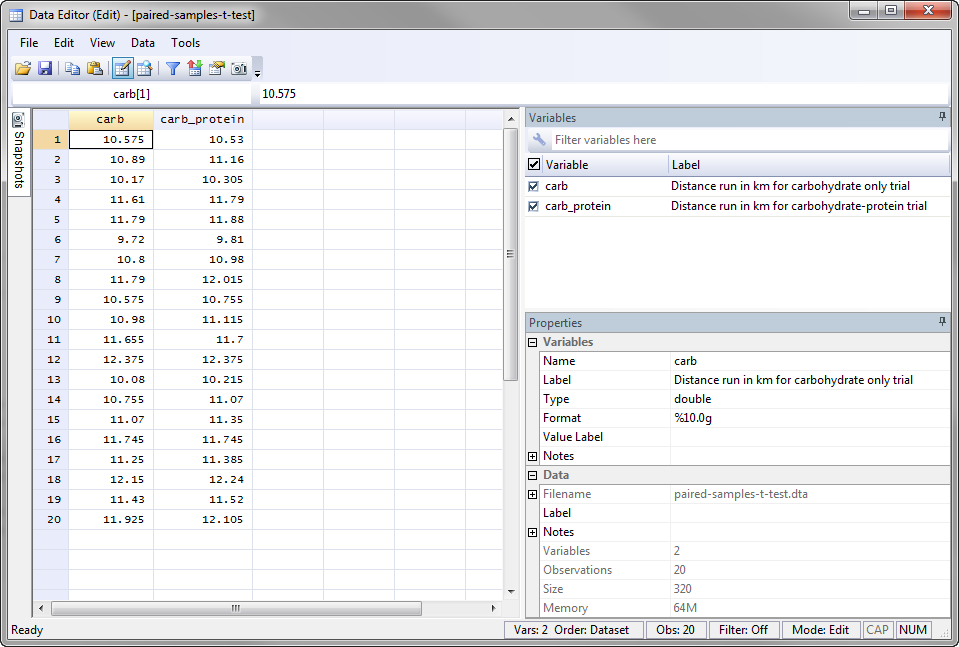

We can then use the original “ratio” equation to determine that the variance of foreign cars is statistically significantly higher than the variance of domestic cars. For this example, if we got a significant p-value, we can then determine that it is statistically significant that the difference is less than () 1 (equation on the right). This allows you to draw some more specific conclusions about your data. However, if the middle p-value was statistically significant, then the two alternate hypotheses will indicate whether the difference between the calculated ratio and 1 is greater than or less than 1. We can assume we have equal variance for the purpose of any subsequent hypothesis test. In this example the middle p-value is not statistically significant so this is where our analysis stops. Note: This FAQ was inspired by several responses to a question on the Statalist.The two alternate hypotheses on the left and right are only of interest if the middle statistic is significant. Regardless of the method that we use, we obtain an F-ratio of 10.45 or a t-value We can use the test command after the svy: regress if we would like to get the F-ratio. If you want to compare more than two groups, or if you want to do multiple pairwise comparisons, use an ANOVA test or a post-hoc test. The sign of the coefficient is different because above, the mean of the females Same coefficient and p-value that we did when we used the lincom command. To do this, simply include the single dichotomous predictor variable.

The svy: regress command can also be used to compute the t-test. We can see from the output above that the means are not statisticallyĮquivalent. * stored by Stata after running the estimation command svy: mean. * The precise value of the t statistic can be obtained from the list of values We can see these labels by using the coeflegend option on the svy: mean command. To use the licom command, we need to know the labels that Stata has assigned to the values in the output. Notice that the p-value is the same as above, and that squaring the t-value yields the F-value shown above ( (-3.23)^2 = 10.45). The lincom command gives us the difference between the means (51.65351 – 55.81467 = -4.161156), the standard error of the difference, as well as the t-value and the p-value. This command should be run after the svy: means command shown above. We could also use the lincom command to test the two means. Prob > F = 0.0014 Method 2: Using the lincom command Male | 51.65351 | 55.81467 that we know what the labels are, we can use them in the test command. Number of PSUs = 200 Population size = 10,481 To use the test command, we need to know the labels that Stata has assigned to the values in the output. Number of PSUs = 200 Population size = 10481

The null hypothesis that these two means are equal. In our dataset, the variable female is coded 1 for females and 0 forįirst, we use the svy: mean command with the over option to get Let’s say that we wish to do a t-test for write by Pretending that the variable socst is the sampling weight (pweight) and that the sample is We will illustrate this using the hsb2 dataset We will show each of these three ways of conducting a t-test with survey data Here’s an example from a recent experiment of mine (where the outcomes are firm survival, and four types of. It is also easy to do a t-test using the svy: regress command. We run the following treatment regressions for outcome j at time t: Y (j,t) a + b1treat1+b2treat2+b3treat3+b4treat4 + c1y (j,0) + d’X + e (j,t) With 5 outcomes and 4 treatments, we have 20 hypothesis tests and thus 20 p-values.

There is no svy: ttest command in Stata however, svy: mean is an estimationĬommand and allows for the use of both the test and lincom post-estimationĬommands.


 0 kommentar(er)
0 kommentar(er)
